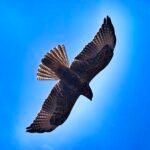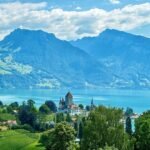Overview of Huangshan:
Huangshan, located in Huangshan City, Anhui Province, is known as “The First Strange Mountain Under Heaven.” If you travel to Huangshan by train or plane, you will arrive in Huangshan City, commonly referred to as “Tunxi” by locals. From there, you can take a bus from the Huangshan Bus Terminal to Tangkou Town, and then transfer to a shuttle bus at the transportation center to reach the Huangshan Scenic Area.
The name “Huangshan” translates to “Emperor’s Mountain,” a tribute to its regal beauty. The famous saying, “After seeing the Five Sacred Mountains, one does not look at other mountains, but after seeing Huangshan, one does not look at the Five Sacred Mountains,” perfectly encapsulates its grandeur. Before visiting, its reputation for majesty already stirs the imagination, but after the visit, all that remains is awe and admiration.
Huangshan is celebrated worldwide for its “Five Wonders”:
- Oddly shaped pines
- Strange rock formations
- The sea of clouds
- Hot springs
- Winter snow
Adding to the mystique are Huangshan’s 82 peaks, each unique in character. Whether grand and imposing or graceful and delicate, they were crafted by nature over millions of years. Among the most captivating are the three main peaks: Tiandu Peak, Lotus Peak, and Bright Summit.
Huangshan’s beauty varies with the seasons. Whether it’s the rugged masculine beauty revealed under the bright sun, the mysterious allure of mist-covered peaks, the romantic charm of blooming flowers in spring, or the pure, holy beauty of snow-covered landscapes in winter, each moment here is an unforgettable experience. Words fail to capture the essence of Huangshan’s magnificence — only a personal visit can do it justice.
Before visiting Huangshan, it’s essential to clarify a few geographical names: Huangshan City, Huangshan District, Huangshan Scenic Area, and Tangkou.
- Huangshan City refers to the administrative city and includes Tunxi District, Huizhou District, and Huangshan District. When locals mention “going back to Huangshan,” they usually mean returning to Tunxi 90% of the time. If you’re traveling by train, the destination on your ticket labeled “Huangshan” actually refers to Tunxi. Similarly, if you’re traveling by long-distance bus, the destination is generally labeled as Tunxi.
- Huangshan District, formerly known as Taiping County, is one of the districts under Huangshan City and is often referred to as the “north gate” to the Huangshan Scenic Area. Interestingly, local bus lines still use the name “Taiping County.”
- Huangshan Scenic Area starts at the entrance to the scenic area and covers the entire mountain landscape. This area is managed directly by the city government.
- Tangkou is the nearest town to the base of Huangshan and is home to the southern gate of the scenic area, which is the most popular access point for tourists. It is 68 kilometers from Tunxi.
Nearly 99% of tourists enter Huangshan from this southern gate at Tangkou, making it the main gathering spot before ascending the mountain.

Best Time to Visit: The best time to visit Huangshan is from April to November, as all scenic spots are open during this period, and the weather is generally pleasant. Summer and autumn offer comfortable temperatures and clear views, making it the most popular time for tourists to enjoy the lush green mountains and expansive scenery. However, if you’re in search of the spectacular sea of clouds, the winter and spring seasons are ideal. In fact, the sparsely visited winter months (late October to February) are often referred to as “the most beautiful season” for Huangshan. During this time, you can marvel at frost, rime, and ice formations, all while benefiting from off-peak ticket prices. Be aware that some trails and scenic areas may be closed during the winter.
Clothing Recommendations: The weather on Huangshan can change rapidly, often alternating between sunshine and rain, so it’s essential to keep an eye on the forecast and come prepared. When climbing, pack light and opt for loose, comfortable clothing that can block the wind. The early morning and nighttime temperatures on the mountain are quite low, so bring extra layers like sweaters or thermals. Wearing breathable clothing is important, so you can change out of damp clothes and avoid catching a cold. It’s also recommended to bring a raincoat, which can provide both rain and wind protection.
For those who are elderly, have health concerns, or plan to visit during winter, staying warm is crucial. Coats can be rented on the mountain for around 30 yuan per coat (an additional 10 yuan during holidays), with a deposit of 60 yuan. Additionally, the sun can be strong on Huangshan, so be sure to bring sunscreen, a hat, and sun-protective clothing.
Best Time and Locations for Viewing the Sunrise:
The ideal spots to watch the sunrise on Huangshan are Qingliangtai, Shuguang Pavilion, Lion Peak, Shixin Peak, Danxia Peak, Bright Summit (Guangmingding), Aoyu Peak, and Yupinglou. Among these, the most recommended locations are Qingliangtai and Lion Peak in Beihai, followed closely by Bright Summit and Yupinglou.
As for the timing, it varies by season:
- Spring: 5:30 – 6:00
- Summer: 4:40 – 5:20
- Autumn: 4:50 – 5:20
- Winter: 5:30 – 6:00
For precise sunrise times during your visit, it’s best to inquire locally, as most hotels and guesthouses within the scenic area post daily schedules.
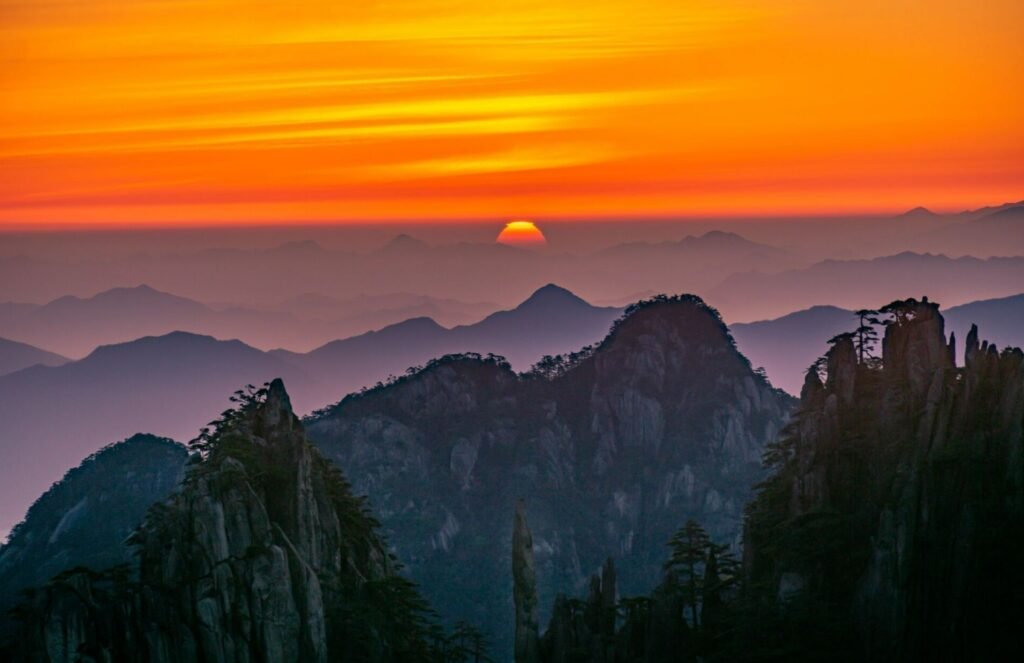
Best Spots to Watch the Sunset
Just like watching the sunrise, the best locations to enjoy the evening glow need to be elevated, open areas that face west. These conditions allow for a full panoramic view of the breathtaking sunset hues. Sunset and the evening glow go hand in hand, making the time just before and after the sun dips below the horizon the ideal moment to catch the evening glow in all its beauty. If you’re planning to take in this sight, make sure to arrive a little early to pick your spot, so you don’t miss the magical moment.
Here are the best places to watch the sunset:
- Guangming Peak
- Paiyun Pavilion
- Danxia Peak
- Flying Stone
- Aoyu Peak
- Western Sea Yao Terrace
For the best view of the Western Sea’s evening glow, Paiyun Pavilion is the top choice.

Best Spots to Watch the Sea of Clouds
From November to May, Huangshan offers the ideal season to witness its breathtaking sea of clouds. After rain or snow, when the sky clears suddenly, the sunrises and sunsets create stunningly colorful cloudscapes—known as the “Rainbow Sea of Clouds,” which are particularly awe-inspiring.
Here are the best spots to experience the sea of clouds:
- Yuping Tower for viewing the Front Sea
- Qingliang Terrace for the Back Sea
- White Goose Ridge for the East Sea
- Paiyun Pavilion for the West Sea
- Guangming Peak for the Heavenly Sea
Each of these locations provides a unique perspective on Huangshan’s mystical cloud formations.
Best Time and Spots to See Snow Scenery
Huangshan typically enters winter around late October, with the peak snow season from December to February. Despite being the off-season for tourism, winter brings a unique charm to Huangshan, with fewer crowds and the opportunity to fully enjoy the breathtaking snowy landscapes, frost-covered trees, and rime ice formations.
Here are the best spots for snow viewing:
- Tiandu Peak
- Lotus Peak
- Jiulong Peak
- West Sea Grand Canyon
- Lion Grove
- Yuping Peak
- Yungu Temple
Winter in Huangshan is far from bleak—it’s an ideal time to visit and experience the serene, snow-draped beauty of the mountains.
If You Don’t Reach Guangming Peak, You Haven’t Truly Seen Huangshan
Guangming Peak is one of the most famous platforms on Huangshan, sitting at an altitude of 1,860 meters, making it the second-highest peak, even higher than Tiandu Peak. It serves as the watershed and natural boundary between the front and back sections of Huangshan. From here, you get the best view of Lotus Peak and Tiandu Peak, offering a panoramic and breathtaking perspective of the surrounding landscape. The expansive views from Guangming Peak make it a must-see spot for any Huangshan visitor.
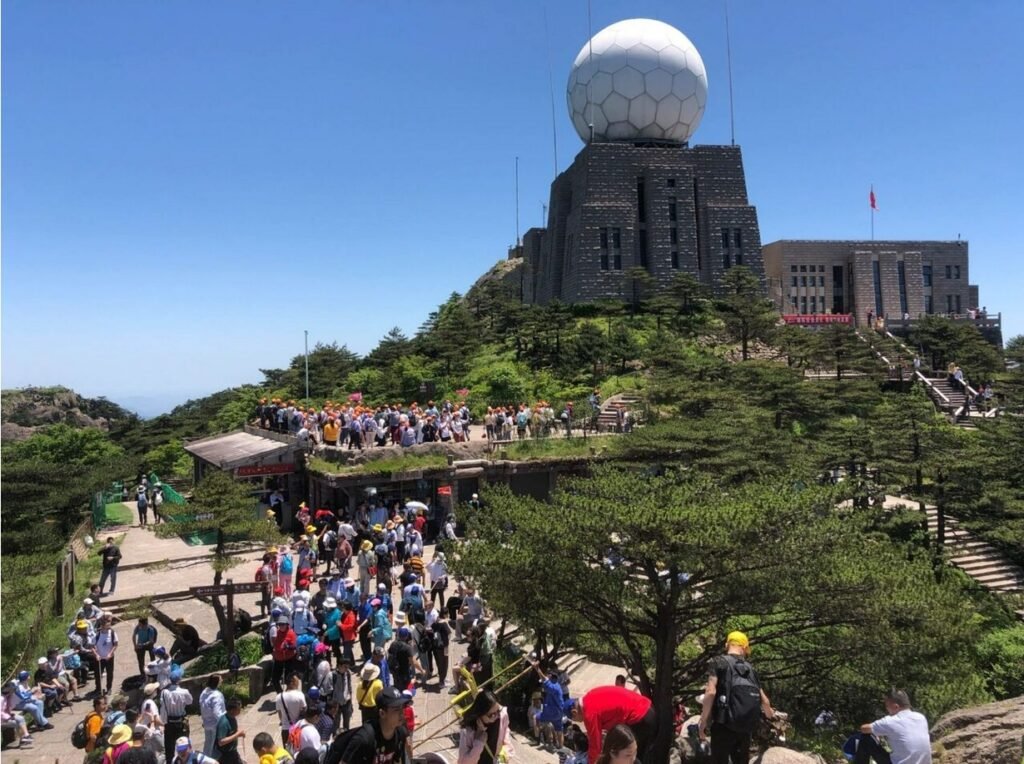
If You Don’t Climb Tiandu Peak, Your Trip is Incomplete
Tiandu Peak, standing at an altitude of 1,830 meters, is known as the most treacherous of Huangshan’s three main peaks. The name “Tiandu” means “Capital of the Immortals” or “Heavenly Metropolis.” Although it doesn’t quite match the height of Huangshan’s highest peak, Lotus Peak, its steep and dangerous paths set it apart. The famous “Hundred-Step Cloud Ladder” is nearly vertical, making the ascent a thrilling challenge. From the top, you get an incredible bird’s-eye view of Huangshan’s awe-inspiring scenery, making the climb well worth the effort.
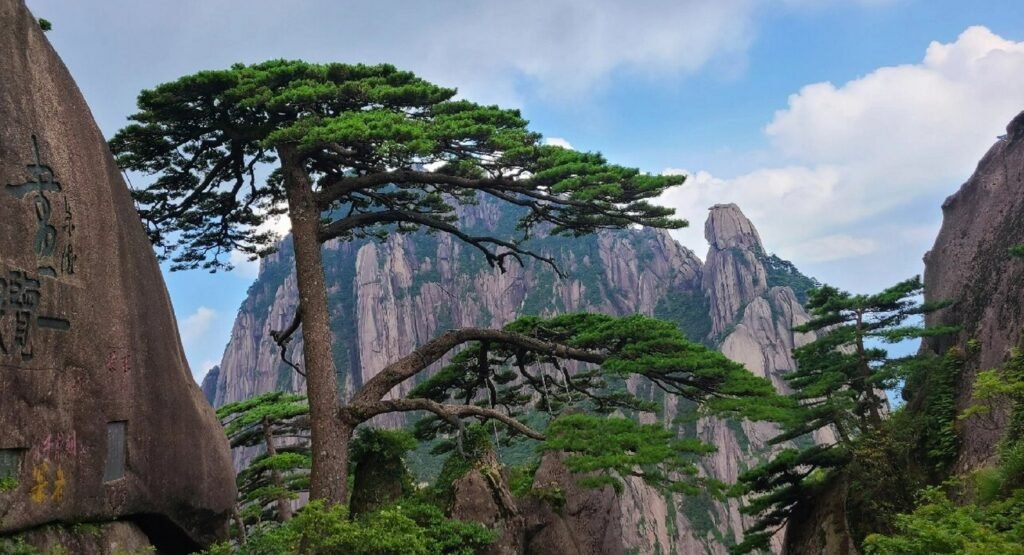

Climbing Routes
Huangshan has two main climbing routes: the front mountain and the back mountain, allowing you to choose based on your personal preferences and fitness levels.
1. Front Mountain Route: This route starts from Ciguang Pavilion and allows you to climb directly to Tiandu Peak. From there, you can descend past Yuping Tower, continue to Guangming Peak, and finally head to Xihai and Beihai, before descending to the back mountain. Key sights along the way include the Welcome Pine, Half-Mountain Temple, Tiandu Peak, Yuping Tower, Lotus Peak, One-Line Sky, and Aoyu Peak. This route is physically demanding, requiring a 15-kilometer hike and about 3 hours of strenuous effort to reach the main scenic areas. The descent is also quite challenging. However, since this route usually has fewer visitors, many physically fit tourists opt for it.
2. Back Mountain Route: This route starts at Yungu Temple, leading to Bai E Ridge, passing Shixin Peak and arriving at Beihai, then continuing to Xihai Grand Canyon and finally reaching Guangming Peak. The highlights include Shixin Peak, Lion Peak, Paiyun Pavilion, and Feilai Stone in the Xihai Grand Canyon. This route is less steep, making it easier to walk. Accommodation is more convenient, and the scenery improves as you go further, making it suitable for those with less stamina.
If you have plenty of time and are in good shape, you can hike the entire Huangshan area on foot. Otherwise, taking the cable car is a great way to save time and energy. However, during peak travel seasons or bad weather, you might face long lines waiting for the cable car, which can be frustrating for travelers.
Accommodation in Huangshan
When traveling to Huangshan, visitors typically choose to stay in Tunxi District, Tangkou, or on the mountain itself. Among these, accommodations on the mountain are the most popular.
Pricing Overview:
- Off-Peak Season: Rates are divided into weekend and weekday pricing. Weekends refer to Friday and Saturday, while Sunday through Thursday are considered weekdays. Weekend rates are usually about 40% higher than weekday rates, so if possible, it’s best to avoid visiting during weekends.
- Peak Season: This includes busy periods like Golden Week and other holidays, where prices fluctuate based on demand. Other times are classified as off-peak pricing.
Booking Tips: Regardless of the season, it’s essential to book your room or bed in advance. During the off-peak season, you typically only need to reserve a day or two ahead, but during peak season, it’s advisable to book at least one to two weeks in advance to ensure availability.
Accommodation on Huangshan Mountain
Huangshan is divided into five main areas: East, South, West, North, and Tianhai, each equipped with accommodation facilities.
Major Hotels: The primary hotels on Huangshan include:
- Baiyun Hotel
- Shilin Grand Hotel
- Beihai Hotel
- Xihai Hotel
Most of these hotels are located on the back mountain, with the exception of YUPing Lou Hotel, which is on the front mountain.
Price Range:
- Standard room rates typically range from ¥80 to ¥500, with an average price of around ¥700 for standard double rooms. During the off-peak season, prices are slightly lower, generally between ¥120 and ¥250.
- The majority of hotels are monopolized by Huangshan Tourism Co., Ltd., with a few exceptions for hotels run by local enterprises like Bai’e Villa, Guangming Ding Lodge, and Xihai Reservoir Hotel.
- Hotels managed by Huangshan Co. usually offer better conditions but come at slightly higher prices.
Choosing Where to Stay: There isn’t a definitive answer to where the best place to stay is; it really depends on your itinerary and personal preferences. Each area has its advantages and disadvantages:
- Beihai, Xihai, and Paiyun Lou: The benefit of staying here is that you can drop off your luggage right after you arrive and explore hands-free. However, you may have to retrace some of your steps.
- Tianhai or Baiyun: The advantage is that you won’t have to backtrack, but you’ll have to carry your luggage for the entire journey.
Room Types: There are primarily three types of accommodations on the mountain:
- Standard Rooms: These are the most expensive options.
- 6-8 Person Dorms with Private Bathrooms: These offer the best value for your money.
- 8-12 Person Economic Beds with Shared Bathrooms: These are budget options, but the conditions can be quite poor.
It’s recommended to opt for the multi-person rooms with private bathrooms, as they offer amenities similar to standard rooms but at a significantly lower price. Shared bathrooms are the most economical choice, but they lack independent facilities, and you won’t be able to shower, which makes for a much tougher experience. Often, if you book too late, private rooms may be fully booked, and you’ll only have the option for shared accommodations.
Booking Tips: Regardless of the season, it’s common to encounter full bookings during peak times. It’s advisable to book your hotel in advance to secure a room, as online reservations usually offer discounts lower than the on-site prices. Otherwise, you might end up renting a coat and sleeping bag to sleep on the floor!
Food Introduction:
Huangshan’s cuisine is part of the Huizhou culinary tradition. The most famous dishes include stinky mandarin fish, hairy tofu, and Huangshan double stone, which you can find along Xixi Street in Tangkou Town, in Tunxi Old Street, and on the mountain itself. Just a heads up, Huizhou dishes tend to be on the salty side, so if that’s not your thing, feel free to order less and give it a try.
One thing to keep in mind is that the prices for food on the mountain can be way higher than those in town. For tasty bites like hairy tofu and stinky fish, it’s best to enjoy them in Huangshan City itself—there are plenty of spots near the train station and in tourist-heavy areas like Tangkou that offer good, authentic food at better prices. When you’re up on the mountain, focus on just filling your belly; it’s a good idea to pack some lightweight snacks and water from Tangkou before heading up.
Also, be cautious about restaurants recommended by local taxi drivers; they often get a kickback from those places, and you’ll likely end up paying more than necessary.
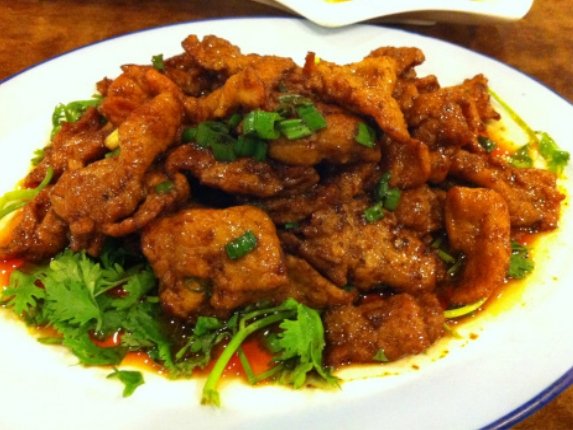
Tiger Skin Hairy Tofu, also known as fermented tofu, was even featured in “A Bite of China.” At first glance, the moldy surface might make you hesitant to dig in, but it’s surprisingly similar to stinky tofu. When you eat it hot, you’ll be hit with a delicious and fragrant flavor that lingers. You can find it at roadside stalls as well as in various restaurants, so there are plenty of chances to give it a try!

Huizhou Stinky Mandarin Fish is a classic dish with over 200 years of history. The traditional way to prepare it is by braising it, which gives the fish a bright red color. Its standout feature is, of course, its “stinky” aroma. The first time you try it, it might take some getting used to, much like durian or stinky tofu. But don’t let the smell fool you—once you take a bite, you’ll find it incredibly crispy and flavorful. It’s a dish that many diners become addicted to! You can find it in restaurants of all sizes throughout the region.
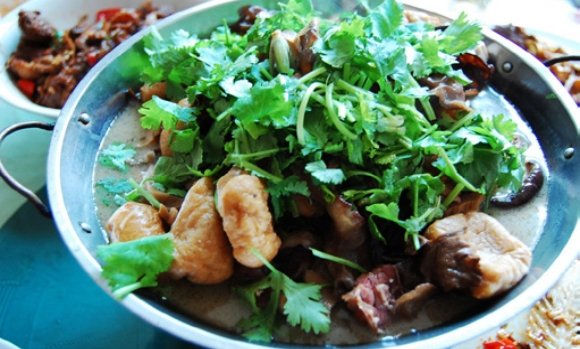
Yipin Guo, or “Imperial Pot,” is a popular hot pot dish that locals in Huangshan often enjoy during the winter months. Legend has it that it got its name after an emperor sampled it at the home of a local official named Bi Qiang in Shitai County. This dish layers dry bamboo shoots, chunks of meat, tofu, meatballs, vermicelli, and vegetables, creating a hearty meal that’s both filling and satisfying. It’s a great way to warm up and enjoy a variety of flavors all in one pot!
Recommended Itinerary: One-Day Tour of Huangshan
Route Highlights: This itinerary focuses on the latest hot spot—Xihai Grand Canyon—making it a must-visit for travelers with limited time and good stamina.
Itinerary Design:
- Starting Point: Tangkou
- Stops: Yun Gu Temple → Xihai Grand Canyon → Yuping Cableway → Tangkou
Detailed Itinerary:
- Night Before: Check into a hotel in Tangkou.
- Early Morning: Depart at 5:30 AM, taking the scenic area’s new national line bus or a taxi to Yun Gu Temple on the back mountain.
- Cable Car Ride: Take the new cable car from Yun Gu up the mountain.
Exploration Highlights:
- Begin your hike: Little Dreamland → Shixin Peak → Black Tiger Pine → Dream Pen Blossoming → Xihai Scenic Area → Paiyun Pavilion.
- Enter Xihai Grand Canyon: Walk across the Immortal Bridge → Rest at Woshi Piyun → Enjoy the views from Xihai Yaotai → Visit Baiyun Hotel → Tianhai → Aoyufeng (Fish Peak) → Aoyudong (Fish Cave) or Yixiantian (One Line Sky) → Baibu Yuntai (Hundred-Step Cloud Ladder) → Lianhua Pavilion (Lotus Pavilion) → Happiness Avenue → Yuping Building.
After snapping a photo with the famous Welcoming Pine, you can either walk back down or take the Yuping cable car.
- Return Trip: Switch to the new national line bus or taxi at Ciguang Pavilion back to Tangkou.
Total Duration: The entire trip, including cable car rides and walking, will take about 8-9 hours. If you choose to walk down from Yuping Building, add about 2 more hours to reach Ciguang Pavilion.
This route gives you a full taste of Huangshan’s breathtaking views and ensures you make the most of your day!

